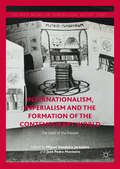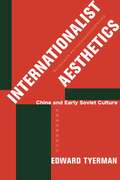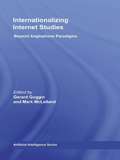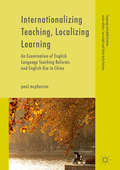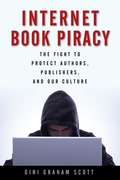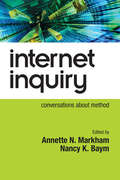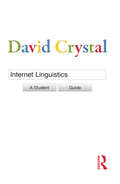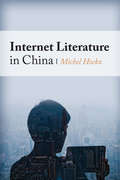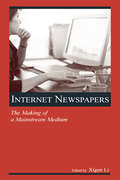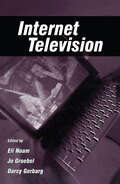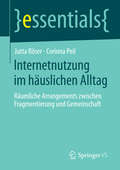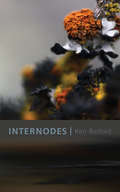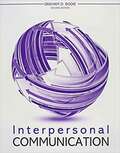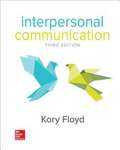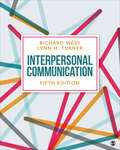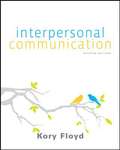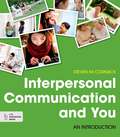- Table View
- List View
Internationalism, Imperialism and the Formation of the Contemporary World
by Miguel Bandeira Jerónimo José Pedro MonteiroThis volume offers innovative insights into and approaches to the multiple historical intersections between distinct modalities of internationalism and imperialism during the twentieth century, across a range of contexts. Bringing together scholars from diverse theoretical, methodological and geographical backgrounds, the book explores an array of fundamental actors, institutions and processes that have decisively shaped contemporary history and the present. Among other crucial topics, it considers the expansion in the number and scope of activities of international organizations and its impact on formal and informal imperial polities, as well as the propagation of developmentalist ethos and discourses, relating them to major historical processes such as the growing institutionalization of international scrutiny in the interwar years or, later, the emerging global Cold War.
Internationalist Aesthetics: China and Early Soviet Culture
by Edward TyermanFollowing the failure of communist revolutions in Europe, in the 1920s the Soviet Union turned its attention to fostering anticolonial uprisings in Asia. China, divided politically between rival military factions and dominated economically by imperial powers, emerged as the Comintern’s prime target. At the same time, a host of prominent figures in Soviet literature, film, and theater traveled to China, met with Chinese students in Moscow, and placed contemporary China on the new Soviet stage. They sought to reimagine the relationship with China in the terms of socialist internationalism—and, in the process, determine how internationalism was supposed to look and feel in practice.Internationalist Aesthetics offers a groundbreaking account of the crucial role that China played in the early Soviet cultural imagination. Edward Tyerman tracks how China became the key site for Soviet debates over how the political project of socialist internationalism should be mediated, represented, and produced. The central figure in this story, the avant-garde writer Sergei Tret’iakov, journeyed to Beijing in the 1920s and experimented with innovative documentary forms in an attempt to foster a new sense of connection between Chinese and Soviet citizens. Reading across genres and media from reportage and biography to ballet and documentary film, Tyerman shows how Soviet culture sought an aesthetics that could foster a sense of internationalist community. He reveals both the aspirations and the limitations of this project, illuminating a crucial chapter in Sino-Russian relations. Grounded in extensive sources in Russian and Chinese, this cultural history bridges Slavic and East Asian studies and offers new insight into the transnational dynamics that shaped socialist aesthetics and politics in both countries.
Internationalization within Higher Education: Perspectives From Japan (SpringerBriefs in Education)
by Elizabeth Stigger Marian Wang David Laurence Anna BordilovskayaThis book discusses what internationalization practices are and the different ways that they are being implemented by higher education institutions in Japan, from a bottom-up perspective. It reflects the current situation faced by many Japanese universities in the context of the changing landscape in higher education and considerations in implementing changes to course curricula, programs, and university admissions with regard to internationalization. The four case studies presented provide readers with clear examples of how the internationalization of higher education institutions is developing within the Japanese higher education system, and the issues that different higher education institutions face in this process.
Internationalizing Internet Studies: Beyond Anglophone Paradigms (Routledge Advances in Internationalizing Media Studies)
by Gerard Goggin Mark McLellandThis timely book offers a mapping of the Internet as it has developed and is used internationally, providing a lively and challenging examination of the Internet and Internet studies. There is much interest among scholars and researchers in understanding the place of the Internet in cultural, social, national, and regional settings. This is the first book-length account that not only provides a range of perspectives on the international Internet, but also explores the implications of such new knowledge and accounts for concepts, methods, and themes in Internet studies. Of special interest will be the book’s fresh and up-to-date coverage of the Internet in perhaps the most dynamic region at present: Asia-Pacific.
Internationalizing Teaching, Localizing Learning
by Paul McpherronBased on ethnographic and policy data collected over a ten-year span at a university in the People's Republic of China, this book analyses the history of English Language Teaching (ELT) polices in Chinese higher education. The book uses the university as a lens in which to investigate the creative imaginations and divergent (re)appropriations of teaching methods, learning materials, and language use in the Chinese ELT context. Book chapters move beyond mere descriptions of tensions and point to the local understandings and practices of English teachers (both local and foreign) and students. Working together, these teachers and students are constantly articulating new social and political conditions and meanings outside and inside given discourses and traditions of ELT. The book's main argument is that these multiple stakeholders must be given a more prominent role in shaping policy and curriculum at universities and other English language contexts around the world.
Interne Unternehmenskommunikation in resilienten Organisationen
by Susanne Knorre Ulrike BuchholzAus der Psychologie entlehnt, erobert der Begriff der Resilienz derzeit die Diskussion um das Führungshandeln in Unternehmen. Resiliente Unternehmen zeichnen sich dadurch aus, dass Rückschläge verarbeitet werden können, weil Strukturen und Prozesse flexibel anpassbar sind - ohne die organisatorische Einheit und kulturelle Identität zu gefährden. Verstanden als Teil der allgemeinen Managementlehre, erläutern die Autorinnen die interne Kommunikation in resilienten Organisationen und liefern fundierte Handlungsempfehlungen für deren Umsetzung.
Internet Book Piracy: The Fight to Protect Authors, Publishers, and Our Culture
by Gini Graham ScottThe international battle against Internet pirates has been heating up. Increasingly law enforcement is paying attention to book piracy as ebook publishing gains an ever-larger market share. With this threat to their health and even survival, publishers and authors must act much like the music, film, and software giants that have waged war against pirates for the past two decades. Now, The Battle against Internet Piracy opens a discussion on what happens to the victims of piracy. Drawing from a large number of interviews-from writers, self-publishers, mainstream publishers, researchers, students, admitted pirates, free speech advocates, attorneys, and local and international law enforcement officials-the text speaks to such issues as: Why pirates have acted and how they feel about it The conflict over constitutional rights and piracy The current laws surrounding Internet piracy Examples of cases taken against some pirates Alternatives to piracy Personal experiences of being ripped off The ways piracy affects different industries and how they’ve respondedAuthor Gini Graham Scott prepares readers to arm themselves against these modern perils by learning about copyright, infringement, and how to prevent, combat, and end book piracy.Allworth Press, an imprint of Skyhorse Publishing, publishes a broad range of books on the visual and performing arts, with emphasis on the business of art. Our titles cover subjects such as graphic design, theater, branding, fine art, photography, interior design, writing, acting, film, how to start careers, business and legal forms, business practices, and more. While we don't aspire to publish a New York Times bestseller or a national bestseller, we are deeply committed to quality books that help creative professionals succeed and thrive. We often publish in areas overlooked by other publishers and welcome the author whose expertise can help our audience of readers.
Internet Inquiry: Conversations About Method
by Nancy K. Baym Annette MarkhamThis collection of dialogues is the only textbook of its kind. Internet Inquiry: Conversations About Method takes students into the minds of top internet researchers as they discuss how they have worked through critical challenges as they research online social environments. Editors Annette N. Markham and Nancy K. Baym illustrate that good research choices are not random but are deliberate, studied, and internally consistent. Rather than providing single "how to" answers, this book presents distinctive and divergent viewpoints on how to think about and conduct qualitative internet studies.
Internet Linguistics: A Student Guide
by David CrystalThe Internet is now an integral part of contemporary life, and linguists are increasingly studying its influence on language. In this student-friendly guidebook, leading language authority Professor David Crystal follows on from his landmark bestseller Language and the Internet and presents the area as a new field: Internet linguistics. In his engaging trademark style, Crystal addresses the online linguistic issues that affect us on a daily basis, incorporating real-life examples drawn from his own studies and personal involvement with Internet companies. He provides new linguistic analyses of Twitter, Internet security, and online advertising, explores the evolving multilingual character of the Internet, and offers illuminating observations about a wide range of online behaviour, from spam to exclamation marks. Including many activities and suggestions for further research, this is the essential introduction to a critical new field for students of all levels of English language, linguistics and new media.
Internet Literature in China
by Michel HockxRanging from the self-consciously avant-garde to the pornographic, web-based writing has introduced innovative forms, themes, and practices into Chinese literature and its aesthetic traditions.
Internet Literature in China
by Michel HockxRanging from the self-consciously avant-garde to the pornographic, web-based writing has introduced innovative forms, themes, and practices into Chinese literature and its aesthetic traditions.
Internet Literature in China (Global Chinese Culture)
by Michel HockxSince the 1990s, Chinese literary enthusiasts have explored new spaces for creative expression online, giving rise to a modern genre that has transformed Chinese culture and society. Ranging from the self-consciously avant-garde to the pornographic, web-based writing has introduced innovative forms, themes, and practices into Chinese literature and its aesthetic traditions. Conducting the first comprehensive survey in English of this phenomenon, Michel Hockx describes in detail the types of Chinese literature taking shape right now online and their novel aesthetic, political, and ideological challenges. Offering a unique portal into postsocialist Chinese culture, he presents a complex portrait of internet culture and control in China that avoids one-dimensional representations of oppression. The Chinese government still strictly regulates the publishing world, yet it is growing increasingly tolerant of internet literature and its publishing practices while still drawing a clear yet ever-shifting ideological bottom line. Hockx interviews online authors, publishers, and censors, capturing the convergence of mass media, creativity, censorship, and free speech that is upending traditional hierarchies and conventions within China—and across Asia.
Internet Newspapers: The Making of a Mainstream Medium (Routledge Communication Series)
by Xigen LiInternet Newspapers: The Making of a Mainstream Medium examines newspapers on the Internet, and addresses the emergence of online newspapers and the delivery of news through this outlet. Utilizing empirical research, chapters explore the theoretical and practical issues associated with Internet newspapers and examine the process through which online newspapers have grown into a mainstream medium. Contributions to this work emphasize three key areas: the structure and presentation of newspapers on the Internet; the medium as an interactive process; and the ways in which the public interacts with Internet newspapers.This collection makes a substantial contribution to the understanding of newspapers on the Internet, covering their development and changes as well as the impact that news delivery through this medium has had on other media, audiences, and society. It also sheds light on improving operation and performance of Internet newspapers to better serve the public and gain competitive knowledge. The volume encourages additional scholarship in this area, and also shows how researchers can benefit from an empirical approach to their examination of Internet newspapers.Internet Newspapers will appeal to scholars, researchers, and students of journalism and mass communications, and can be used as a supplementary text in advanced courses covering journalism, communication technology, and mass media and society.
Internet Television (European Institute for the Media Series)
by Darcy Gerbarg Eli Noam Jo GroebelInternet TV is the quintessential digital convergence medium, linking television, telecommunications, the Internet, computer applications, games, and more. Soon, venturing beyond the convenience of viewer choice and control, Internet TV will enable and encourage new types of entertainment, education, and games that take advantage of the Internet's interactive capabilities. What Internet TV is today and can be in the future forms the context for this book. Arising from collaboration between the Columbia Institute for Tele-Information (CITI) and the European Institute for the Media (EIM), this volume investigates the advent of widely available individual broadband Internet communications and their impact on the development of Internet TV. Editors Eli Noam, Jo Groebel, and Darcy Gerbarg have collected seminal papers by leaders from the U.S. and European media and technology industries that offer a critical look at the impact of interactivity on television content, and address the need for media organizations to create interactive programming in this untapped realm with unclear consumer interest and desires. Each section of the volume fleshes out key issues and concepts of television and the Internet: *Part I, Infrastructure Implications of Internet TV, discusses questions about the required network capacity for various quality grades to deliver individualized broadband to homes. *Part II, Network Business Models and Strategies, addresses the business challenges of making Internet TV a financial success. *Part III, Policy, examines policy issues, including copyright and regulation. *Part IV, Content and Culture, reviews available content, those creating it, and how consumers view Internet TV content. *Part V, Future Impacts, considers future global prospects for Internet TV content creation and distribution. Internet Television is an essential resource for professionals and scholars in new technology and media studies, media policy, telecommunication, broadcasting, and related areas. It is also appropriate for graduate seminars in telecommunications, media and new technologies, and broadcasting and the Internet.
Internetnutzung im häuslichen Alltag: Räumliche Arrangements zwischen Fragmentierung und Gemeinschaft (essentials)
by Jutta Röser Corinna PeilDer Beitrag präsentiert aktuelle Befunde zur Internetnutzung im häuslichen Alltag. Die Autorinnen nehmen zunächst eine Systematisierung alltagsbezogener Rezeptionsforschung der Cultural Studies vor und führen den Domestizierungsansatz ein. Auf Basis ethnografisch orientierter Haushaltsstudien wird anschließend aufgezeigt, auf welche Weise Internetnutzung, räumliche Arrangements und häusliche Kommunikationsstrukturen miteinander interagieren. Abschließend werden verschiedene Arrangements beschrieben und deren Einflüsse auf die Herstellung von Gemeinschaft und Fragmentierung, auf geschlechtsgebundene Praktiken sowie auf Funktionen anderer Medien, insbesondere des Fernsehens, skizziert.
Internodes
by Ken Belford BelfordMoving with nomadic grace across the terrain of his previous book, Decompositions, the poetic language of Ken Belford in Internodes shares similar roots, traversing decades at the speed of a search query - pressing onward through Hazelton, the Bulkley Valley, and the unroaded head-waters of the Nass River in the Damdochax Valley - and meanwhile coming to terms with a poetry that "is lived" on the rugged streets of Prince George.In this twenty-first-century evolution, and one may say "mutation," of Marshall McLuhan's oft-repeated adage that "the medium is the message," Belford's text takes into account the nature of viral marketing and the impact of similar forms of social "trending" on our lives and our language, challenging linearity and order in favour of a work that may be read forward or backward or experienced with an abrupt sense of intimacy, in media res.Whether reflecting upon the internodal segment that is a vital part of a nerve cell; upon the relationship between the nodes and internodes of a plant stem; or upon the internode merely as an interstice of jargon amid connections we forge through high-speed telecommunication and wireless networks, the text invites the reader to make an informed decision before inviting others to "Like," to "Favourite," or to otherwise invest their social currency in Internodes.In addition to perceiving the poem as the "means of transmission" over time, Belford's poetic lines welcome readership as a form of collaborative action and agency in an age of crowdsourcing and flash mobs - and also as a form of ongoing social process that is sensitive to the life and demise of many of the decision trees that ultimately nourish our wavering notions of the future.
Interpersonal Communication
by Richard West Dr Lynn H TurnerInterpersonal Communication, Fourth Edition empowers you to become a more confident communicator by providing you with both the knowledge and the practical skills you need to make effective communication choices in today's rapidly changing and technologically advanced society. Rather than "telling" you how to communicate, authors Richard L. West and Lynn H. Turner offer a toolbox of key skills pertaining to each communication theory so you can actively choose and experiment with strategies appropriate for a given situation. Filled with realistic examples and scenarios that reflect the diversity and interactions of today's students, this practical text makes clear connections among theory, skills, and the life situations we all encounter on a daily basis. New to the Fourth Edition: New personal reflection questions for the IPC Careers and IPC Around Us features help you discover the relevance of interpersonal communication in your everyday life. A new applied theory feature, IPC Praxis, shows you how to apply the theories outlined in the chapter narrative to your life experiences. New chapter wrap-ups, key questions for application, and communication application tests provide you with opportunities to assess what you have learned in the chapter. SAGE edge provides you with helpful tools, including eFlashcards, practice quizzes, and more, in one easy-to-use online environment.
Interpersonal Communication
by Richard West Dr Lynn H TurnerInterpersonal Communication, Fourth Edition empowers you to become a more confident communicator by providing you with both the knowledge and the practical skills you need to make effective communication choices in today's rapidly changing and technologically advanced society. Rather than "telling" you how to communicate, authors Richard L. West and Lynn H. Turner offer a toolbox of key skills pertaining to each communication theory so you can actively choose and experiment with strategies appropriate for a given situation. Filled with realistic examples and scenarios that reflect the diversity and interactions of today's students, this practical text makes clear connections among theory, skills, and the life situations we all encounter on a daily basis. New to the Fourth Edition: New personal reflection questions for the IPC Careers and IPC Around Us features help you discover the relevance of interpersonal communication in your everyday life. A new applied theory feature, IPC Praxis, shows you how to apply the theories outlined in the chapter narrative to your life experiences. New chapter wrap-ups, key questions for application, and communication application tests provide you with opportunities to assess what you have learned in the chapter. SAGE edge provides you with helpful tools, including eFlashcards, practice quizzes, and more, in one easy-to-use online environment.
Interpersonal Communication
by Graham D. BodieThis book gives excellent information about how a student can develop interpersonal communication skills.
Interpersonal Communication
by Kory FloydKory Floyd McGraw-Hill Education, 22 May 2012 - Language Arts & Disciplines - 480 pages 0 Reviews Kory Floyd's approach to interpersonal communication stems from his research on the positive impact of communication on our health and well-being. Interpersonal Communication, 2e demonstrates how effective interpersonal communication can make students' lives better. With careful consideration given to the impact of computer-mediated communication, the program reflects the rapid changes of the modern world in which today’s students live and interact. The program also helps students understand and build interpersonal skills and choices for their academic, personal, and professional lives.
Interpersonal Communication
by Richard West Lynn H TurnerWith its unique skill-building approach, Interpersonal Communication provides students with the knowledge and practice they need to make effective choices as communicators in today′s rapidly changing, technologically advanced, and diverse society. Rather than "telling" students how to communicate, authors Richard L. West and Lynn H. Turner integrate skill sets in each chapter so students can apply what they learn to their own lives. Rich with current examples and coverage of technology, social media, and diversity, this new Fifth Edition makes clear connections among theory, skills, and the situations we all encounter daily. This title is accompanied by a complete teaching and learning package in SAGE Vantage, an intuitive learning platform that integrates quality SAGE textbook content with assignable multimedia activities and auto-graded assessments to drive student engagement and ensure accountability. Unparalleled in its ease of use and built for dynamic teaching and learning, Vantage offers customizable LMS integration and best-in-class support.
Interpersonal Communication
by Richard West Lynn H TurnerWith its unique skill-building approach, Interpersonal Communication provides students with the knowledge and practice they need to make effective choices as communicators in today′s rapidly changing, technologically advanced, and diverse society. Rather than "telling" students how to communicate, authors Richard L. West and Lynn H. Turner integrate skill sets in each chapter so students can apply what they learn to their own lives. Rich with current examples and coverage of technology, social media, and diversity, this new Fifth Edition makes clear connections among theory, skills, and the situations we all encounter daily. This title is accompanied by a complete teaching and learning package in SAGE Vantage, an intuitive learning platform that integrates quality SAGE textbook content with assignable multimedia activities and auto-graded assessments to drive student engagement and ensure accountability. Unparalleled in its ease of use and built for dynamic teaching and learning, Vantage offers customizable LMS integration and best-in-class support.
Interpersonal Communication (Second Edition)
by Kory FloydKory Floyd's approach to interpersonal communication stems from his research on the positive impact of communication on our health and well-being. Interpersonal Communication, 2e demonstrates how effective interpersonal communication can make students' lives better. With careful consideration given to the impact of computer-mediated communication, the program reflects the rapid changes of the modern world in which today's students live and interact. The program also helps students understand and build interpersonal skills and choices for their academic, personal, and professional lives.
Interpersonal Communication And You: An Introduction
by Steven McCornackSteven McCornack, the award-winning teacher, noted scholar, and bestselling author, has done it again. Interpersonal Communication and You maintains the best theory, up-to-date research, engaging examples, and personal voice seen in Reflect and Relate but with a new focus on student self-reflection, application, and adaptive learning. The compelling read is paired with a simplified feature program that prompts students to measure concepts against their personal experiences while encouraging them to build essential skills to further improve their interpersonal lives. Interpersonal Communication and You is available in a variety of digital formats, including the brand-new, time-saving LaunchPad edition that combines an interactive e-book, LearningCurve adaptive quizzing, over 70 integrated video activities, and ready-made assessment options curated into easy-to-assign units inside one convenient learning program.
Interpersonal Communication Research: Advances Through Meta-analysis (Routledge Communication Series)
by Mike Allen Barbara Mae Gayle Raymond W. Preiss Nancy A. BurrellThis exceptional collection--a compilation of meta-analyses related to issues in interpersonal communication--provides an expansive review of existing interpersonal communication research. Incorporating a wide variety of topics related to interpersonal communication, including couples and safe sex, parent-child communication, argumentativeness, and self-disclosure, the contributions in this volume also examine such basic issues as reciprocity, constructivism, social support in interpersonal communication, as well as gender, conflict, and marital and organizational issues. With contributions organized into five sections, this volume: *sets the stage for independent meta-analyses; *provides an overview of individual characteristics in interpersonal communication and the meta-analyses reflecting this theme; *explores the dyadic and interactional approaches to interpersonal communication; and *examines the impact of the meta-analyses on the understanding of interpersonal communication. As a resource for interpersonal communication researchers at all levels, this volume establishes a solid foundation from which to launch the next generation of study and research.
